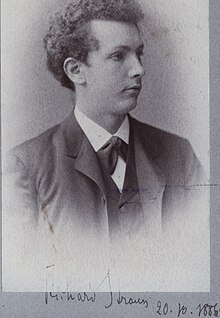Violin Sonata (Strauss)
The Violin Sonata in E-flat, Op. 18 was written by Richard Strauss between 1887-1888. Although not considered a milestone in violin literature, it is frequently performed and recorded. It is often noted for its lyrical beauty and its technical demands made on both violinist and pianist.[1]

History
Following the completion of his Cello Sonata and Piano Sonata, Strauss began working on his Violin Sonata in 1887, and finished it in 1888. It was during this time that Strauss fell in love with Pauline de Ahna, the soprano whom he would later wed, and his amorous feelings can be heard throughout the piece.[2]
Structure
Like all of his chamber music, Strauss' sonata follows standard classical form, though it is considered the last of his works to do so.[3] The piece is in three movements, and takes approximately thirty minutes to perform:
- Allegro, ma non troppo
- Improvisation: Andante cantabile
- Finale: Andante - Allegro
The first movement opens with a brief piano solo, followed by lyrical violin interludes, through which the thematic material is presented. This movement follows typical sonata-allegro form, and although it begins in a melancholy tone, the movement ends jubilantly.
The second movement is unique in that it is an Improvisation; that is, the tranquil violin passages give the impression of improvisational material. This movement maintains a beautiful singing tone throughout, and ends meditatively.
The third and final movement begins with a slow, methodical piano introduction which then leads into an exuberant Allegro. After a rush of virtuosic passages from both performers, the sonata comes to an explosive end.
Notable recordings
- Jascha Heifetz, released by RCA Victor.
- Ginette Neveu, released by EMI Records.
- Gidon Kremer, released by Deutsche Grammophon.
- Sarah Chang, released by EMI Records.
- Vadim Repin, released by Erato Records.
See also
References
- ^ Kennedy, Michael. "Richard Strauss: Man, Musician, Enigma". Cambridge University Press, 1999.
- ^ Kennedy, Michael. "Richard Strauss: Man, Musician, Enigma". Cambridge University Press, 1999.
- ^ All Music Guide, "Classical Archives: Richard Strauss - Violin Sonata in Eb, Op. 18". Classical Archives. January 25, 2010 <http://www.classicalarchives.com/work/56375.html#tvf=tracks&tv=about>
External links
- Violin Sonata, Op. 18: Scores at the International Music Score Library Project
- Performance of Violin Sonata by Korbinian Altenberger (violin) and Hsin-Bei Lee (piano), from the Isabella Stewart Gardner Museum in MP3 format
